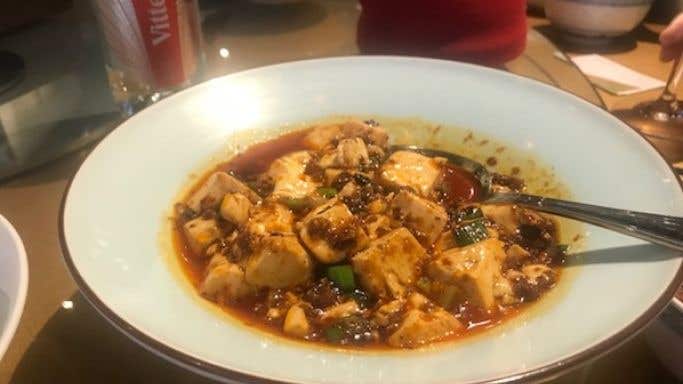A version of this article is published by the Financial Times.
Jeannie Cho Lee MW, who lives in Hong Kong Central, kindly organised a dinner for us at The Chairman restaurant, an occasion that followed our participation in FT-sponsored events at the recent Hong Kong Literary Festival.
The meal involved considerable planning. Discussions were entered into a week before the event with Danny Yip, The Chairman’s restaurateur, and the chef Kwok Keung-Tung, but the dishes were finalised only a couple of days ahead when the chef could be assured of what was freshest in the market. The fried rock lobster meat with snap beans and peas was the highlight of this consistently excellent meal.
When Jeannie asked me at the end of dinner where else I was planning to eat during my short stay, I mentioned Deng G in Wanchai. She confessed she had never eaten there.
This conversation highlighted two phenomena. The first is that all of us use a relatively limited number of restaurants that are tried and tested. Bill Granger, the highly successful Australian chef/restaurateur believes that most people frequent no more than six. These are places that we enjoy and in which we feel particularly welcome.
The second is more particular. Those who live in Hong Kong may be extremely cosmopolitan in their outlook but they tend to live and eat within certain well-known areas. Wanchai is adjacent to Central. In fact it took me only 15 minutes to walk there from The Murray hotel the following day, but it has a very different feel to it.
The buildings are lower so there is the chance to see more of the sky. The shops, restaurants and cafes are less expensive. It seems more of a working area. All of these reasons struck a chord with Paul Hsu.
Hsu is the executive director of Elite Concepts, the successful restaurant group based throughout Asia that combined with chef Deng Huadong to open Deng G in Wanchai two years ago. The site obviously appealed to the relaxed Hsu. It had been a former Hunan restaurant, so the kitchen was in the right place, and the rent was appropriate.
‘Rent is every restaurant’s greatest fixed cost, so keeping it as low as possible is important. Wanchai is less expensive than Central and I am not a Central guy. And Central is not Hong Kong', the jeans-wearing Hsu maintains.
Deng G is therefore an excellent example of one of the principles behind every successful restaurant, that what lies outside the front door must match what is on the inside. This restaurant’s address, 147 Queens Road East, comes with a few further surprises.
The address is actually an office block, the Weswick Commercial Building, with a tired-looking concierge on the ground floor preoccupied with reading his newspaper. Walk past him, up two flights of stairs, and you come face to face with the kitchen.
A design feature, walls covered in bamboo canes, is there to remind all who pass by of Huadong’s origins. These are in the city of Chengdu, capital of Sichuan province, that is at once home to pandas, whose natural diet is bamboo, and to the peppers that make Sichuan cooking the hottest in the whole of China. In less adept hands they can make eating Sichuan food monotonous and unpleasant. (A glass of suanmeitang – sour plum juice in English – is the effective traditional Chinese antidote to a throat on fire, I was told.)
The design and layout of the menu could not be uglier. A large piece of paper, protected on all sides by plastic, lists all the dishes on one side, from the starters to the three desserts, while the other side lists drinks, excluding vintages, for the rather impressive array of wines on offer.
The obvious feature of all the cooking at Deng G is that it is hot but never overpoweringly so. Such is the combination of chilli and garlic that the aromas from the dishes actually seem to precede their arrival. My taste buds were never overpowered.
We began with a selection of starters, from mild okra with a ginger sauce, via jelly fish marinated in vinegar, to the spiciest of them all, a dish of ox tongue mixed with tripe. We then chose two soups, of which one, hot and sour tofu soup, was excellent.
Tofu, bean curd, was also to feature in a first-class rendition of ma po tofu, the classic dish of tofu, red chilis and pork meat that was a fine accompaniment to deep-fried fish in mala sauce, another mouth-tingling and well-executed sauce. All this was accompanied by sautéed string beans and a bowl of dan dan noodles, another not quite so fiery combination. Our dessert, dumplings in a sweet rice soup, came as a welcome relief.

That night, as though the chillis had hooked me, I returned to Deng G for supper. The crisp fish in a spicy sauce and the prawns cooked in a vinegary sauce laden with peppers, were just as good. I will return. There is something in Szechuan cooking when it is as good as this that is addictive. The peppers perhaps.
The Chairman 18 Kau U Fong, Central, Hong Kong; tel +852 2555 2202
Deng G 2/F 147 Queens Road East, Wanchai, Hong Kong; tel +852 2609 2328

